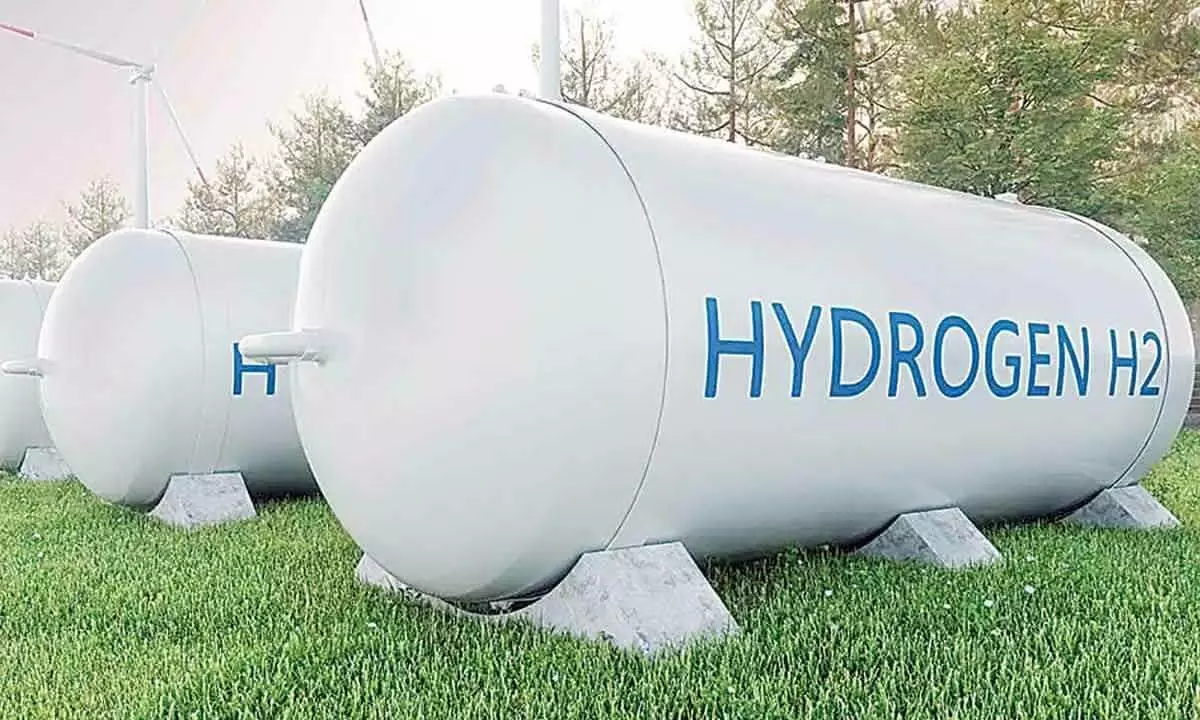IOC bets on green hydrogen
Aims to make the green fuel at least 10% of its requirements by 2030; Setting up green hydrogen plants at its Panipat, Mathura refineries
image for illustrative purpose

What is green hydrogen?
• Hydrogen is cleanest known energy source but it barely exists in a pure form on Earth
• It either is bounded with oxygen in water or with carbon to form hydrocarbons
• Once separated from other elements, hydrogen's utility increases
• Green hydrogen is produced using electrolysis powered by renewable energy to split water molecules into oxygen and hydrogen, creating an emissions-free fuel
New Delhi: Indian Oil Corporation (IOC) is targeting to replace at least a tenth of its current fossil-fuel-based hydrogen at its refineries with carbon-free green hydrogen as part of a decarbonization drive.
To start with, the nation's largest oil firm is setting up green hydrogen plants at its Panipat and Mathura refineries, IOC said in its latest annual report. "The company is venturing into green hydrogen production and is targeting 5 per cent of hydrogen produced by it as green hydrogen by 2027-28 and 10 per cent by 2029-30," it said. Hydrogen is the cleanest known energy source but it barely exists in a pure form on Earth. It either is bounded with oxygen in water or with carbon to form hydrocarbons like fossil fuels.
Once separated from other elements, hydrogen's utility increases: it can be converted into electricity through fuel cells, it can be combusted to produce heat or power without emitting carbon dioxide, used as a chemical feedstock, or as a reducing agent to reduce iron ores to pure iron for steel production. Most of the hydrogen currently produced is grey which is produced from fossil fuel and as carbon emissions. Green hydrogen is produced using electrolysis powered by renewable energy to split water molecules into oxygen and hydrogen, creating an emissions-free fuel. As part of its decarbonisation drive, IOC is looking to replace hydrogen made by unabated fossil fuels with green hydrogen. Petroleum refining accounts for almost 42 per cent of total global hydrogen demand.
"At present, the refineries are the major consumption centres for hydrogen, used for desulfurisation. The current dominant hydrogen production process is highly carbon-intensive being based on the Steam Methane Reforming process. "On the other hand, green hydrogen i.e. hydrogen produced from electrolysis of water, using renewable energy, has a zero-carbon profile, making it the preferred form of hydrogen in the context of a carbon neutral future," IOC said. In the annual report, IOC Chairman Shrikant Madhav Vaidya said to meet the net-zero commitment, the Indian government has announced the Green Hydrogen and Ammonia Policy to boost green hydrogen production to 5 million tonne by 2030 and make India an export hub for this clean fuel.
"Aligning with the national priority, Indian Oil will be producing green hydrogen in stages at the Mathura and Panipat refineries. As a first step, we will be implementing a 5 KTA (40 MW) green hydrogen plant at Mathura Refinery and a 2 KTA (16 MW) plant at Panipat Refinery," he said. To sync with the entire hydrogen value chain, the firm has forged crucial collaborations to develop green hydrogen production assets, associated renewable assets and manufacture electrolysers. "This will be a gamechanger as electrolysers contribute to approximately 30 per cent of the overall cost of green hydrogen," he said. IOC, he said, is also exploring multiple hydrogen production pathways, including solar electrolysis, biomass gasification and bio-methanation. "The hydrogen produced will be used for fuelling 15 fuel cell buses to establish the efficacy, efficiency and sustainability of the fuel cell technology and hydrogen production processes. In addition, we will commission a hydrogen dispensing station at the Gujarat Refinery to enlarge hydrogen-based mobility coverage," he said. IOC said it is looking to expand its footprint in the renewable power space from the present level of about 240 MW capacity.
While renewable energy plants currently produce electricity equivalent to 5 per cent of its electricity consumption, IOC is targeting nearly 5 GW of renewable electricity generation capacities by 2025 for use at its oil refineries. The refinery sector is an emissions-intensive sector, accounting for 3 per cent of global carbon emissions.

